FC Arouca spent the first five decades of its existence in the lower leagues of Portuguese football. In 2013, after four promotions in seven years, the club reached the Primeira Liga for the first time.
Following four years in the top flight, the club suffered relegation back to the second tier in 2019 but bounced back within two seasons. Since returning to the Primeira Liga in 2021, Arouca finished 15th in their first season, followed by an impressive fifth-place finish in 2022/23 with Armando Evangelista at the helm.
Evangelista declined a contract renewal, so Daniel Ramos was appointed manager for the 2023/24 campaign. After one victory in 11 league games, Ramos was dismissed in November.
To turn around their dreadful start to the season, Arouca turned to Daniel Sousa, who had only one previous managerial role to his name. Sousa agreed and took charge at Estádio Municipal.
The 39-year-old recently started working as a manager in his own right after acting firstly as a match analyst and then as the long-term assistant manager to André Villas-Boas.
Sousa gained plenty of experience working alongside Villas-Boas at Premier League clubs, such as Chelsea and Tottenham Hotspur. Additionally, he followed the former Porto manager further afield to Zenit and Shangai Port.
When Daniel Sousa took charge of Arouca on November 15, they were bottom of the table, having scored just nine goals in 11 league games. Sousa has initiated something or a minor miracle. Since then, Arouquenses have climbed to seventh in the table, becoming a goal-scoring machine in the process and picking up some impressive results, including a 3-2 victory against Porto.
In this tactical analysis, we will investigate the tactics used by Sousa to turn Arouca’s season around. We will assess the changes he has made since being appointed as manager and the impact these have had on the on-field performances.
Daniel Sousa Formations
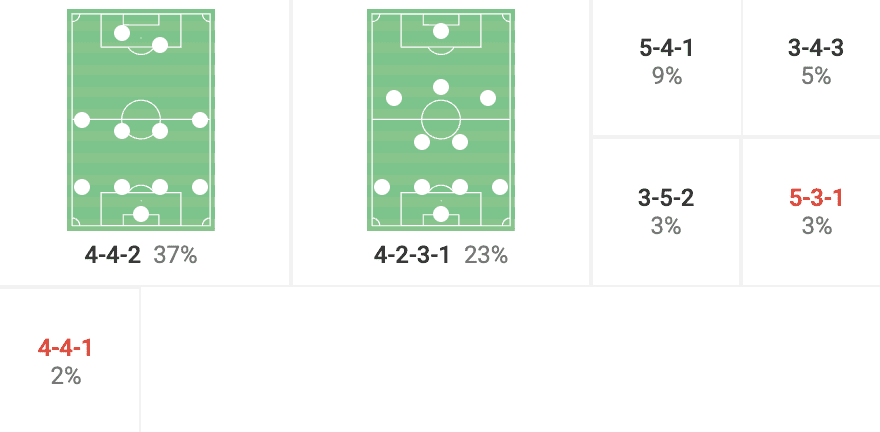
Under Ramos, Arouca primarily played a 4-4-2 or a 3-4-3 system, depending on the opponent. Since Sousa’s arrival, he has stuck with the 4-4-2 system as his go-to tactical setup, occasionally slipping into a 4-2-3-1 as it’s so easy to manoeuvre between the two.
Both systems offer a balanced structure and defensive solidity. The midfielders work together to control the centre of the pitch, with two wide players providing width and support in both the attacking and defensive phases of play.
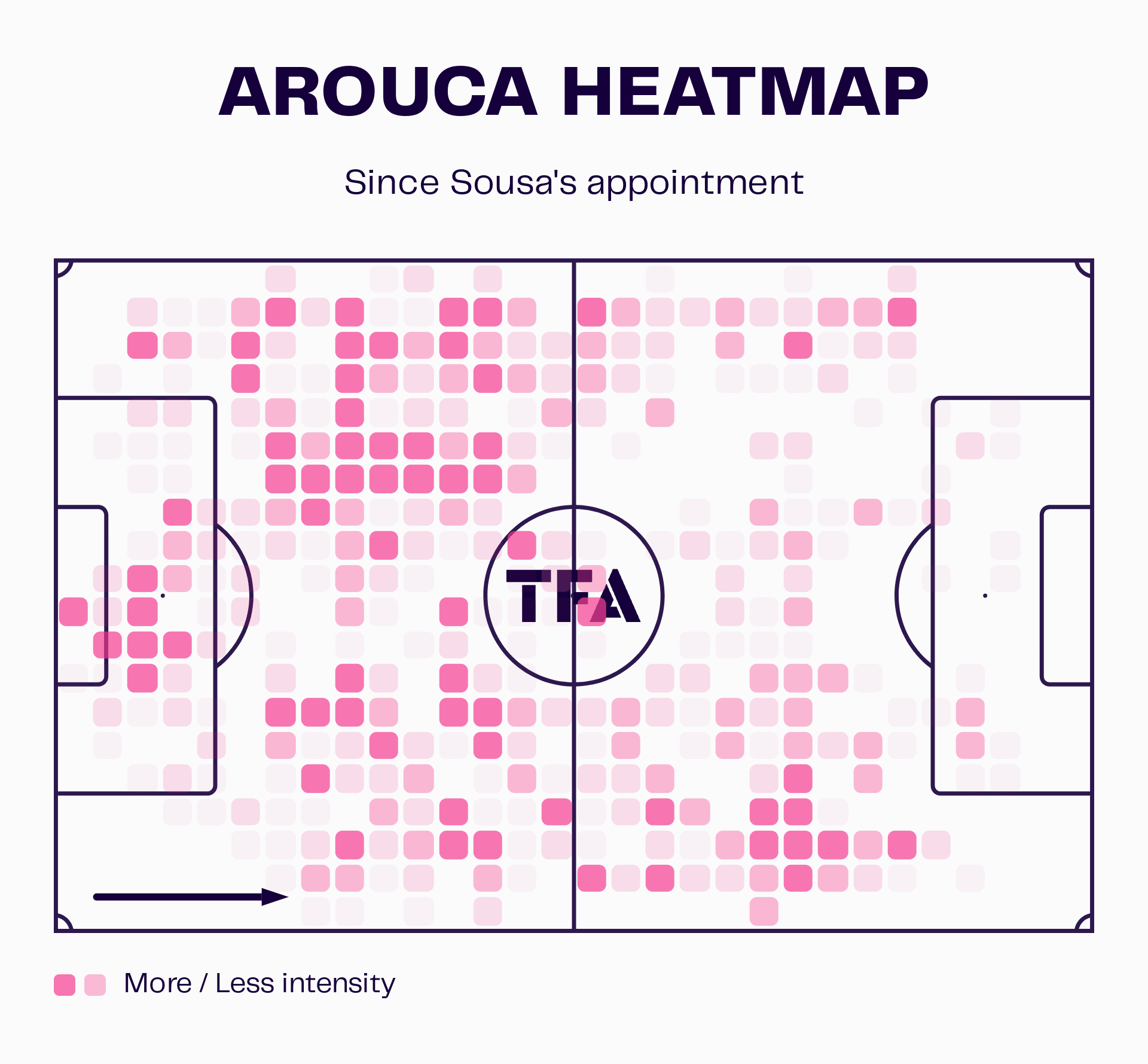
The heatmap shows us where Arouca are most active on the pitch since Sousa’s appointment as manager. We can see they are most active inside their own half and down the flanks. Averaging 51.02% possession per 90, Arouca are not concerned with dominating possession. Instead, they look to be effective in transitions and exploit the spaces left open by the opposition.
Arouca’s heavy focus on a solid and compact midfield and defensive structure makes them well-suited to regaining possession in the middle of the park, and rapid transitions initiate counterattacking play.
Fluidity in attack leading to goals
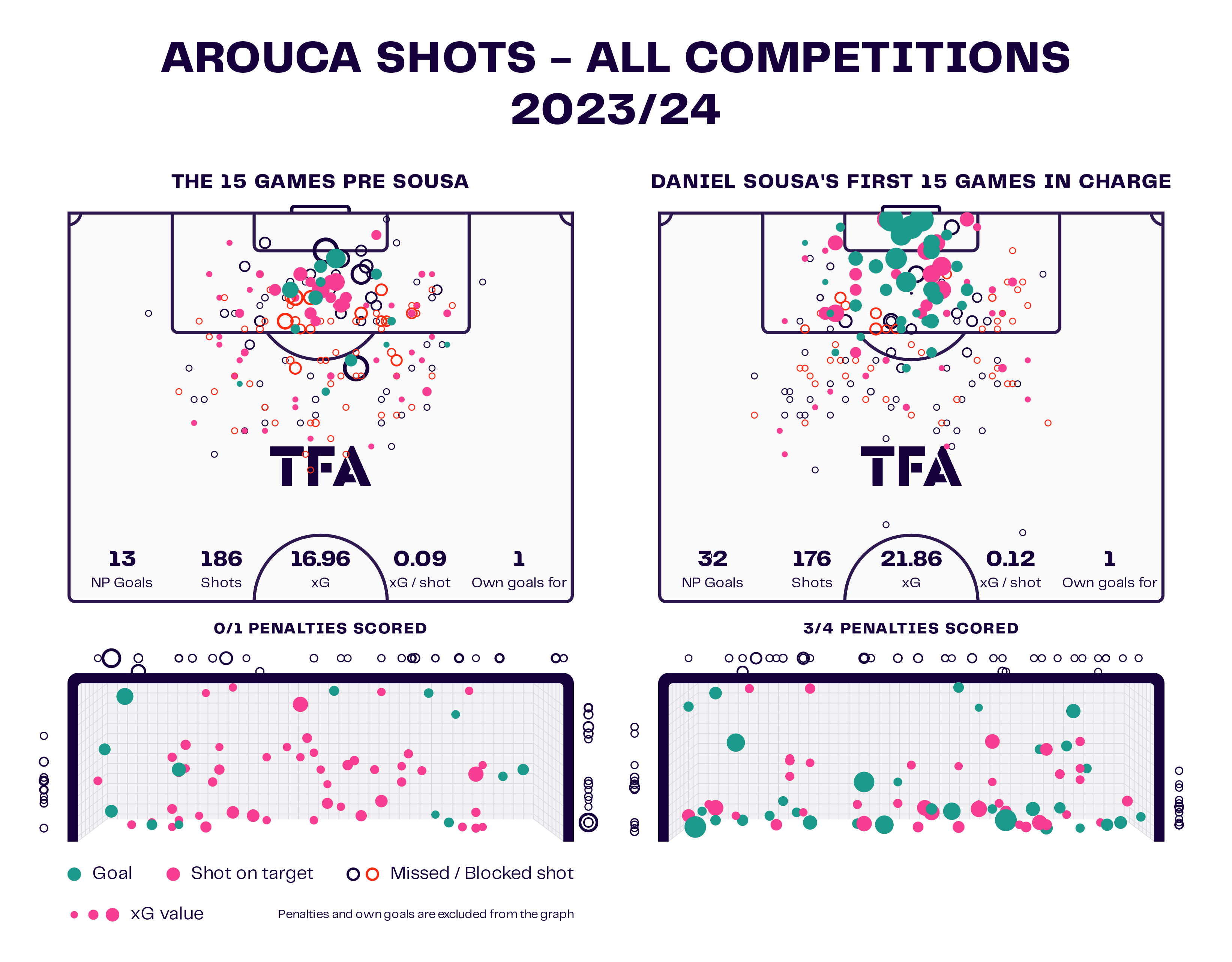
The most immediate change in Arouca’s fortunes since Sousa’s arrival has definitely been the upturn in the number of goals scored. We can see from the data viz that in the 15 games in all competitions prior to Sousa’s appointment, Arouca only found the back of the net on 13 occasions from an xG of 16.96. Furthermore, we can see that the team took 186 shots during this period, suggesting they were rather wasteful with their shooting.
In the first 15 games of Sousa’s reign, Arouca scored 32 non-penalty goals from an xG of 21.86. This represents a huge turnaround in the team’s performance in front of goal. Moreover, during this period, Arouca took 176 shots, suggesting that the chances they are now creating are much higher quality than before.
We will now use the rest of this section of the analysis to investigate how Arouca are able to carve out these goalscoring opportunities. To begin, let’s take a look at how they build up.
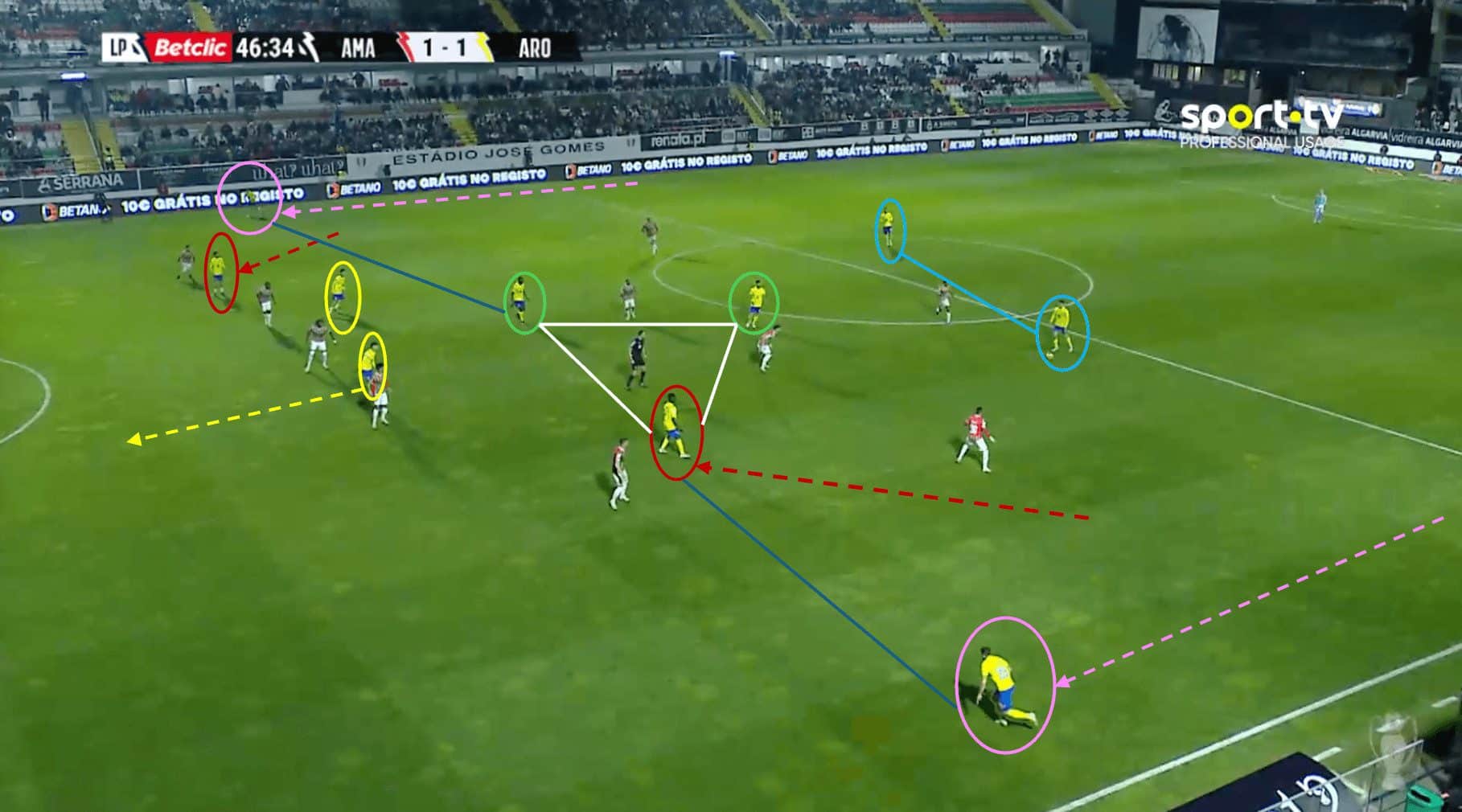
Fluid off-the-ball movement is critical to Arouca’s build-up play. The image above showcases this movement in the game against Estrela da Amadora, approximately six weeks after Daniel Sousa was hired as manager.
The fullbacks (highlighted in pink) will often stay wide and push up as high as possible, meaning they become the primary outlet during build-up play. To accommodate this, the wingers (highlighted in red) move into more central areas.
In this example, Sylla, the left-winger, tucks into a central midfield area, while Jason, the right-winger, joins up with Cristo González and Rafa Mújica (yellow) to form a front three.
As we can see, this lends itself to a 2-1-4-3 shape, with Sylla forming a midfield trio with the two central midfielders (green), which enables Arouca to ensure they do not get overrun in central areas should they lose possession.
Such movement unsettles defenders and disrupts their defensive shape. When Arouca’s attackers make intelligent runs, the opposition defenders must constantly adjust their positions. This movement can lead to defensive confusion, leaving gaps for attackers to exploit.
Furthermore, this also provides passing options for the player in possession of the ball. By constantly moving into open spaces and showing for the ball, teammates offer themselves as passing targets, allowing for quick ball circulation and progression up the field. This not only maintains possession but also prevents the opposition from easily pressuring the ball carrier.
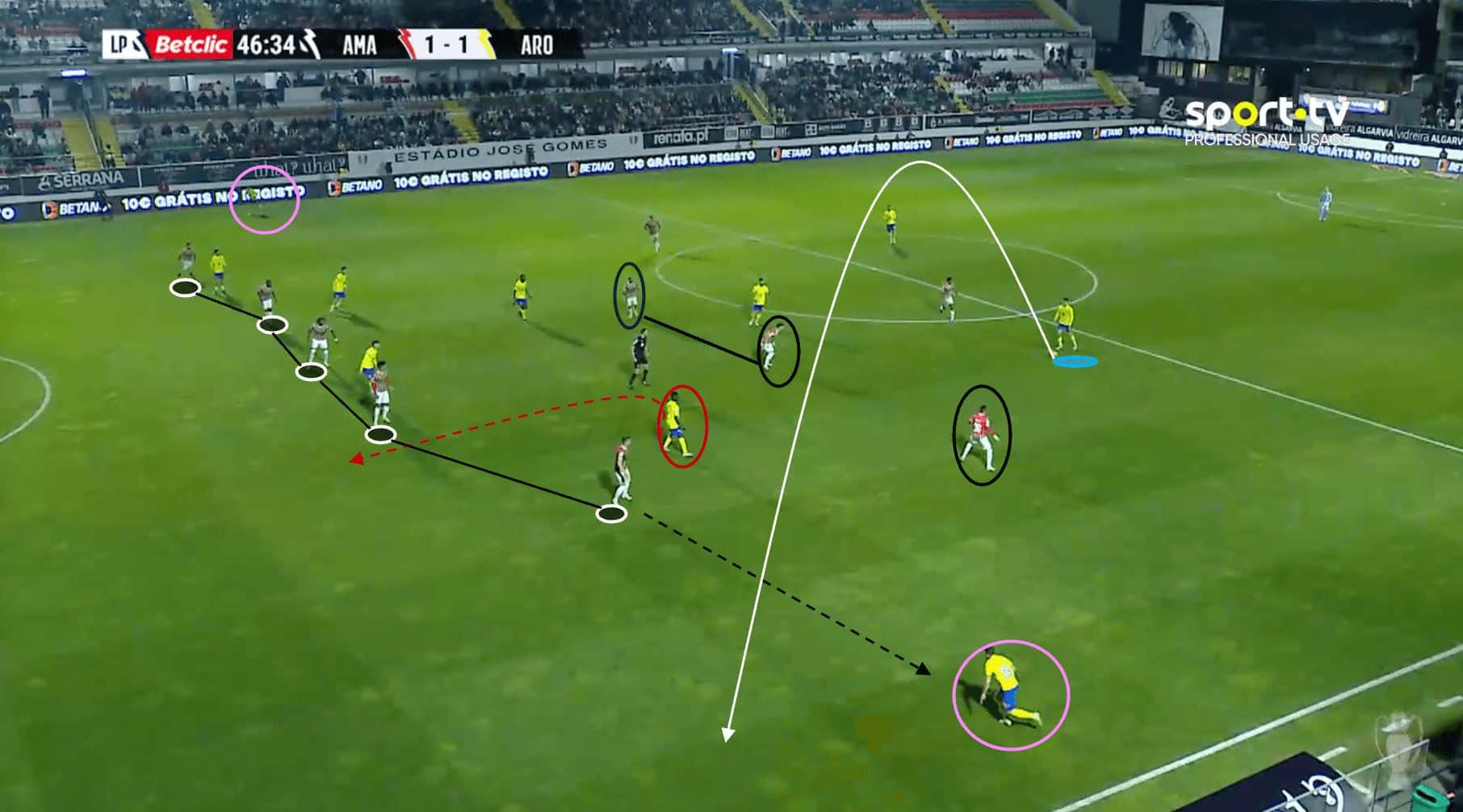
If we look at the same situation from the opposition’s point of view, we can understand how Arouca’s movement leads to spaces being created. With Estrela looking to remain compact, it just allows the two fullbacks to push forward with acres of space available on both sides. Sylla’s movement centrally also pins the Estrela wing back infield, allowing even more space for Montero’s long pass to find Tiago Esgaio.
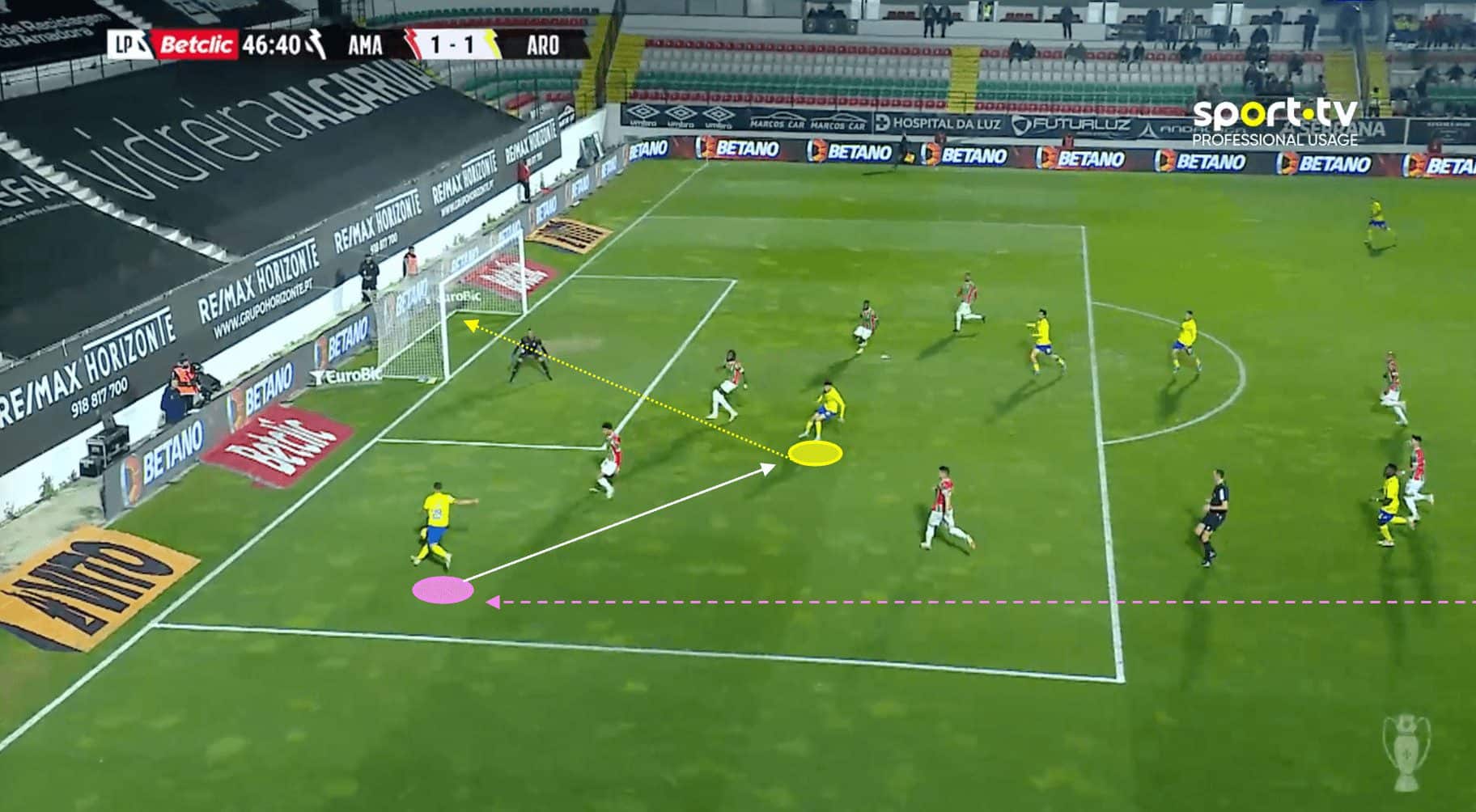
This sequence plays out quickly, which is a crucial element to Arouca’s attacking style – don’t hang around. Averaging 3.96 passes per possession per 90, Daniel Sousa has implemented a rapid attacking system designed to catch their opponents off guard. Here, the ball is played down Arouca’s left flank, and then stand-in left-back Tiago Esgaio plays the ball into Rafa Mújica, who promptly turns it home.
By quickly shifting the ball from one area of the pitch to another, Arouca can stretch the opposition’s defence and create space in dangerous areas. This allows the attackers to make penetrating runs and receive through passes in these areas.
In addition, this enhances Arouca’s ability to maintain possession and control the tempo of the game. Sousa’s preference to keep the ball moving at a high pace means they can dictate play and force the opposition to chase the ball, again creating openings which can be exploited via quick and intricate passes.

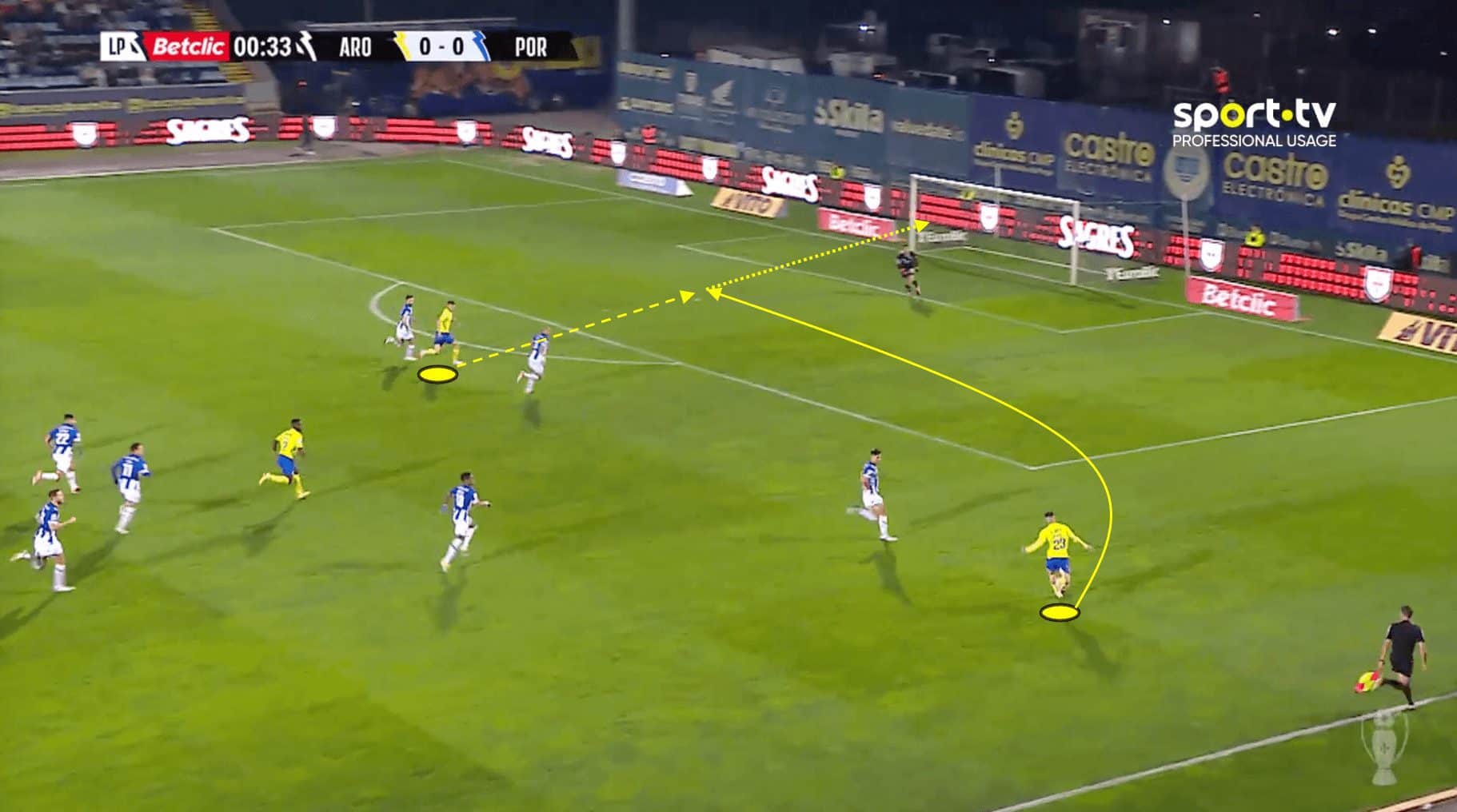
Moreover, Arouca looks to attack from the off. Here, we can see them build an attack straight from kick-off. Morlaye Sylla has drifted from the left wing right over to the right side of the pitch. With Porto looking to press right from kick-off, huge spaces have opened up for the home team to exploit.
The team then execute a quick interchange of passes and works the ball out to Cristo González, who positions himself on the right wing. He carries the ball forward and whips in a cross, which is met by Rafa Mújica’s diving header into the far corner.
The Spanish triumvirate
At the heart of Arouca’s attack are three Spanish players: Jason, Cristo González and Rafa Mújica. The three consistently demonstrate some impressive link-up play and work together almost effortlessly in Sousa’s fluid system.
Mújica is the primary striker and has stepped his game up a level this season, having netted 18 goals so far this season (at the time of this report being written), 13 after Daniel Sousa became manager.
Mújica’s goals so far this season have come from an xG of 13.51, indicating he is capable of scoring lower-percentage chances, such as long shots, which is why he has been in such lethal form this season. Additionally, Cristo González, who plays either as Mújica’s strike partner or a little further back as a number ten, has also chipped in with 14 goals and eight assists to date.
Now, let’s break down some of the key stats for each player to understand how they perform on a per-90 basis. Rafa Mújica’s goal-scoring form equates to 0.58 goals per 90 from an xG per 90 of 0.43. Additionally, Cristo González acts as a link-up man, averaging 0.64 key passes per 90, which indicates he is a creative player who carves out shooting opportunities for others.
Right-winger Jason averages 3.56 dribbles per 90, indicating that Arouca looks to him to carry the ball forward when attacking down the right side. Plus, his 5.35 progressive passes per 90 show he has the ability to play line-breaking passes to advance the ball into the opposition half or the attacking third.
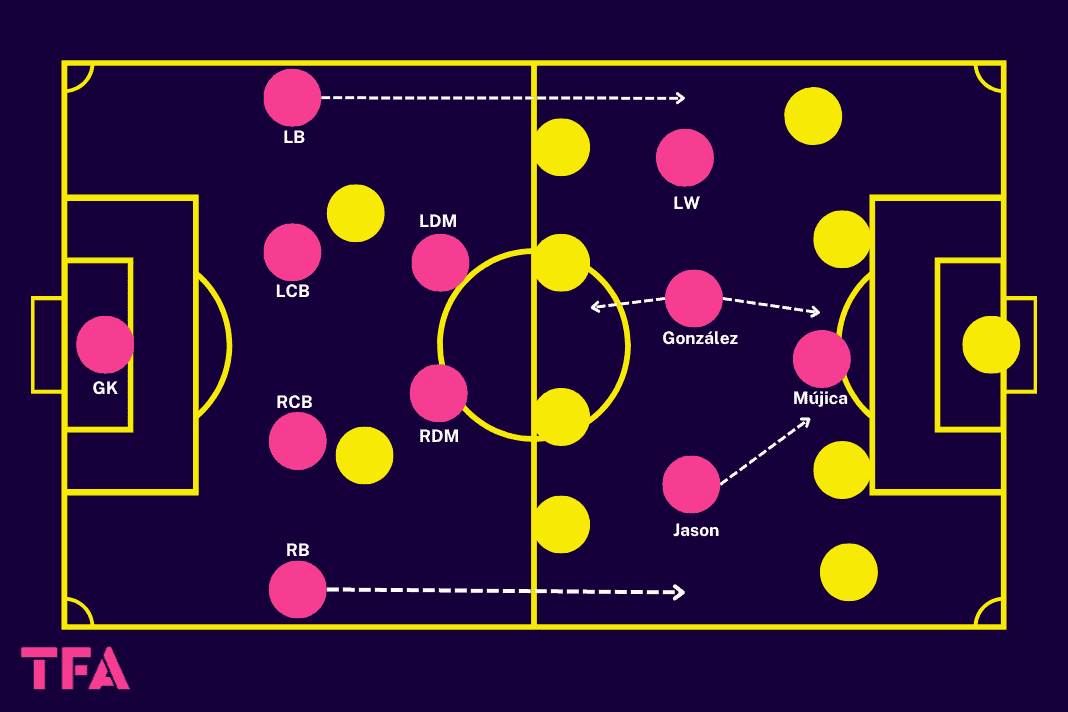
The three players’ movement is crucial to Sousa’s attacking style. This visual shows how the trio instinctively move with each other on the pitch. Typically, Mújica is the central striker and will remain as such. He does look to drop deeper to create space for Cristo González or Jason, or they step forward to create space for the Spanish talisman to operate in.
As we already know, Jason looks to cut inside, allowing for the overlapping run from the fullback. He will try to make runs in behind the opposition’s defensive line to push them back, creating the space for Cristo González to operate effectively as a number ten.
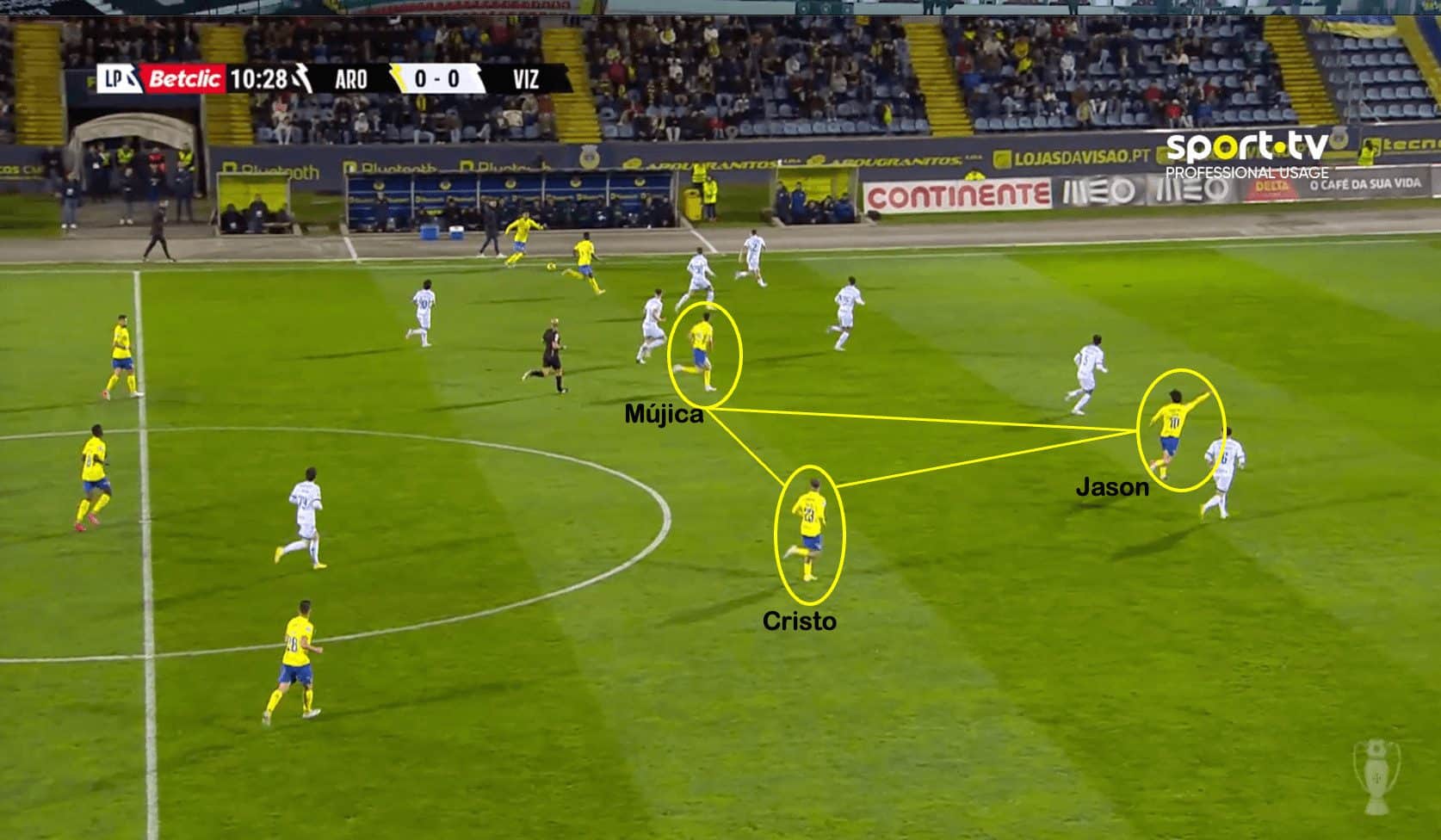
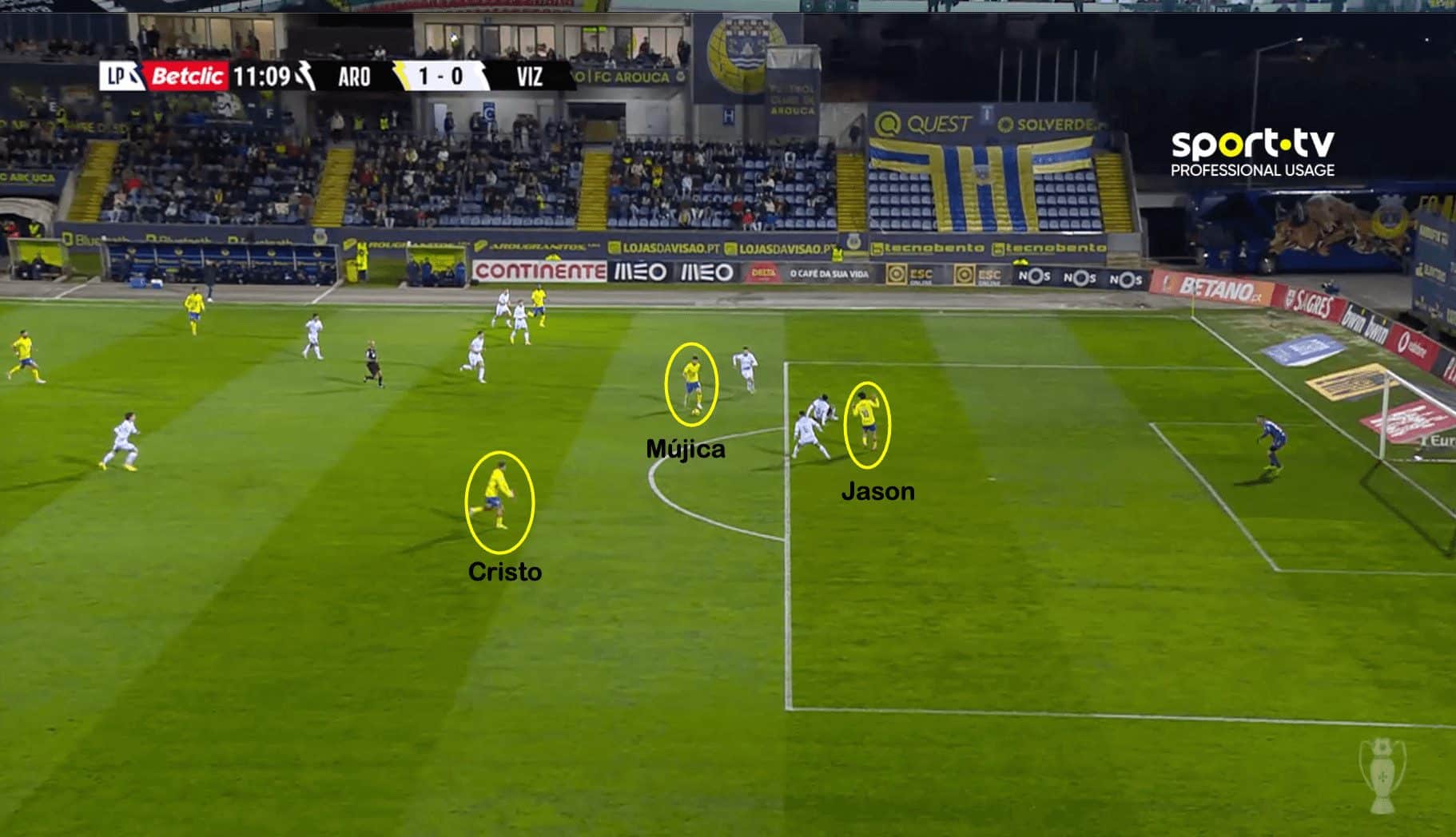
In this instance, we can see the trio alternating their positions as Arouca looks to build an attack. Jason is making a run in behind the defensive line, which creates the space for Mújica and Cristo. Jason forces the defensive line back, allowing his teammates to adopt optimal goalscoring positions.
On this occasion, there is a clear pass in behind to Jason, which is how this sequence plays out. The pass in behind the defence gets knocked back to Mújica, who has plenty of space. Additionally, we can see the space Cristo also has available to him. Mújica opts to execute a powerful shot from the edge of the area into the bottom corner, beating the goalkeeper with its sheer power.
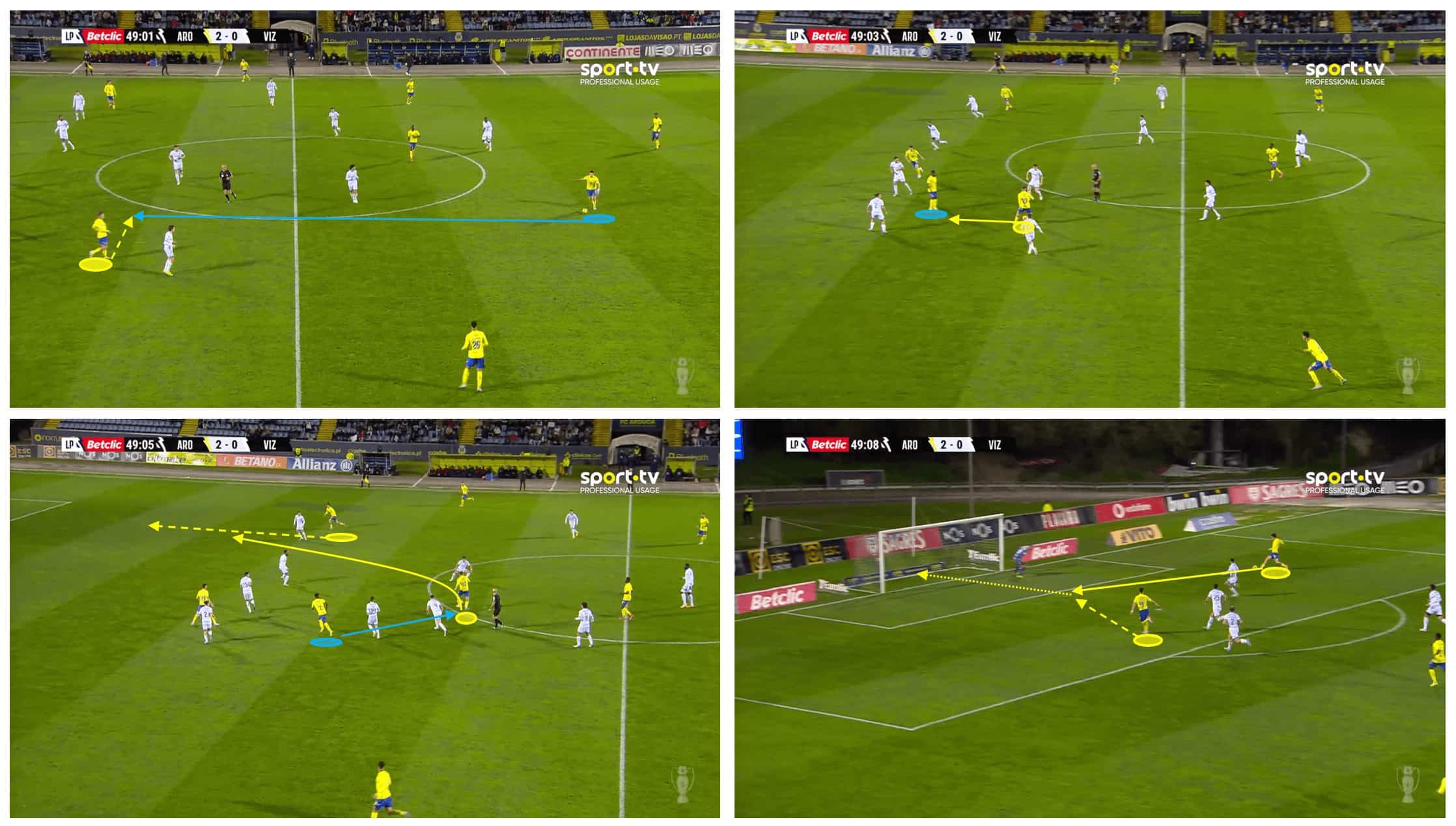
Here, we can see another example of how the trio link up when Arouca are building an attack. The central defender plays the ball into Cristo’s path, he controls the ball and plays a quick one-two with Sylla.
Cristo then plays the ball into Jason’s path, making one of his trademark runs behind the opposition’s defence in the wide right area. The winger carries the ball into the box and plays it to Mújica, who calmly turns it into the net – a goal scored in Portugal but made in Spain.
This is a wonderful demonstration of how the three players look to consistently bring each other into play and link up throughout the game.
Defensive ideas and frailties
Under Daniel Sousa’s style of play, Arouca are not a relentlessly high-pressing team; instead, they are strategic with it and seek to press their opponents at different points throughout the game — most notably, at the beginning of each half.
You may have noticed in the earlier examples (against Estrela and Porto) that Arouca scored just one minute into the second and first halves. Scoring early in the first or second half is another aspect of Sousa’s tactical style. He prefers his team to be in control of games. Hitting their opponent early in the half is designed to knock the wind out of their sails, so to speak.
This means the opposition must take more risks and push forward in search of goals; consequently, spaces are left for Arouca to exploit through their rapid transitions and quick build-up play.
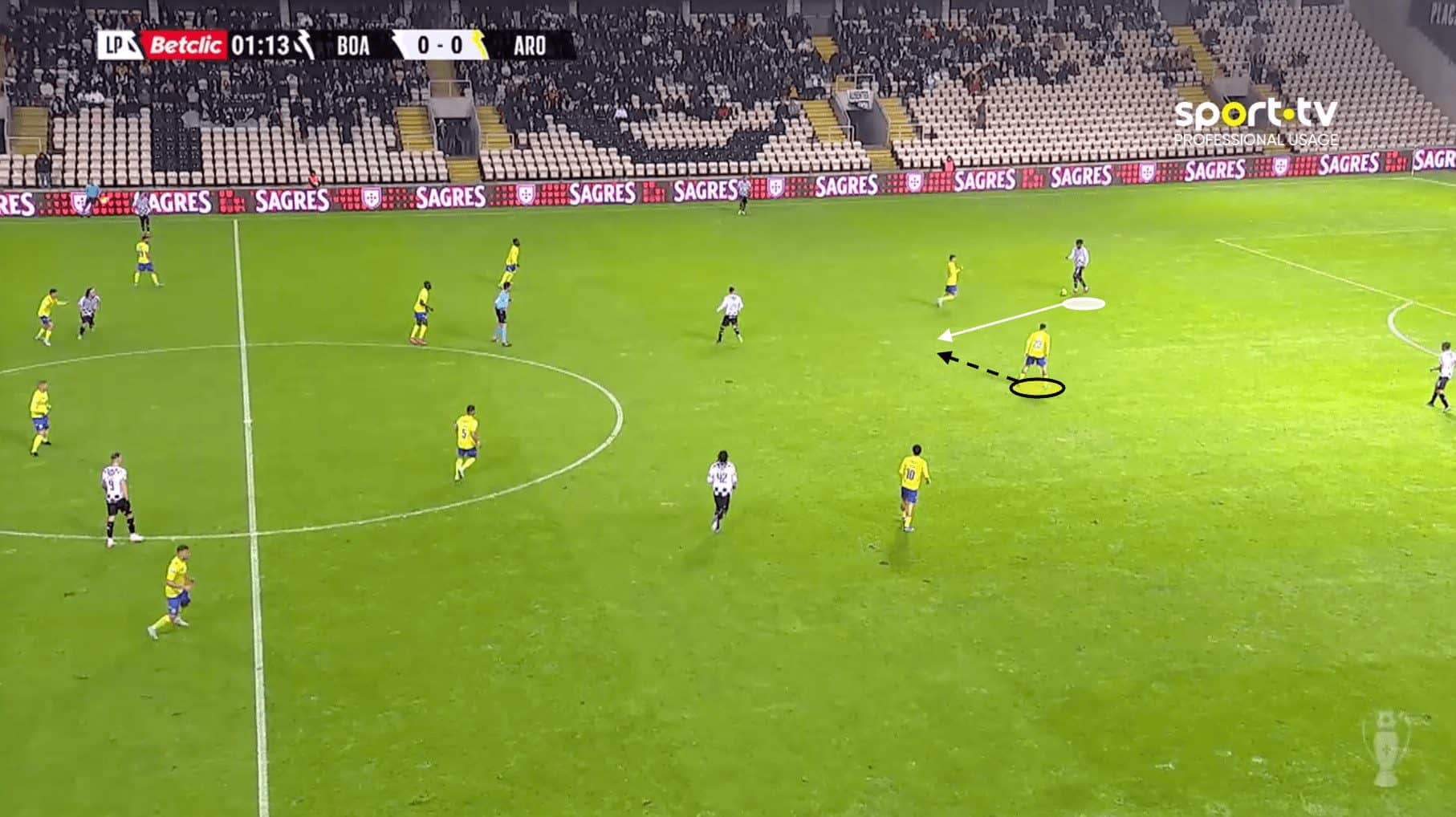
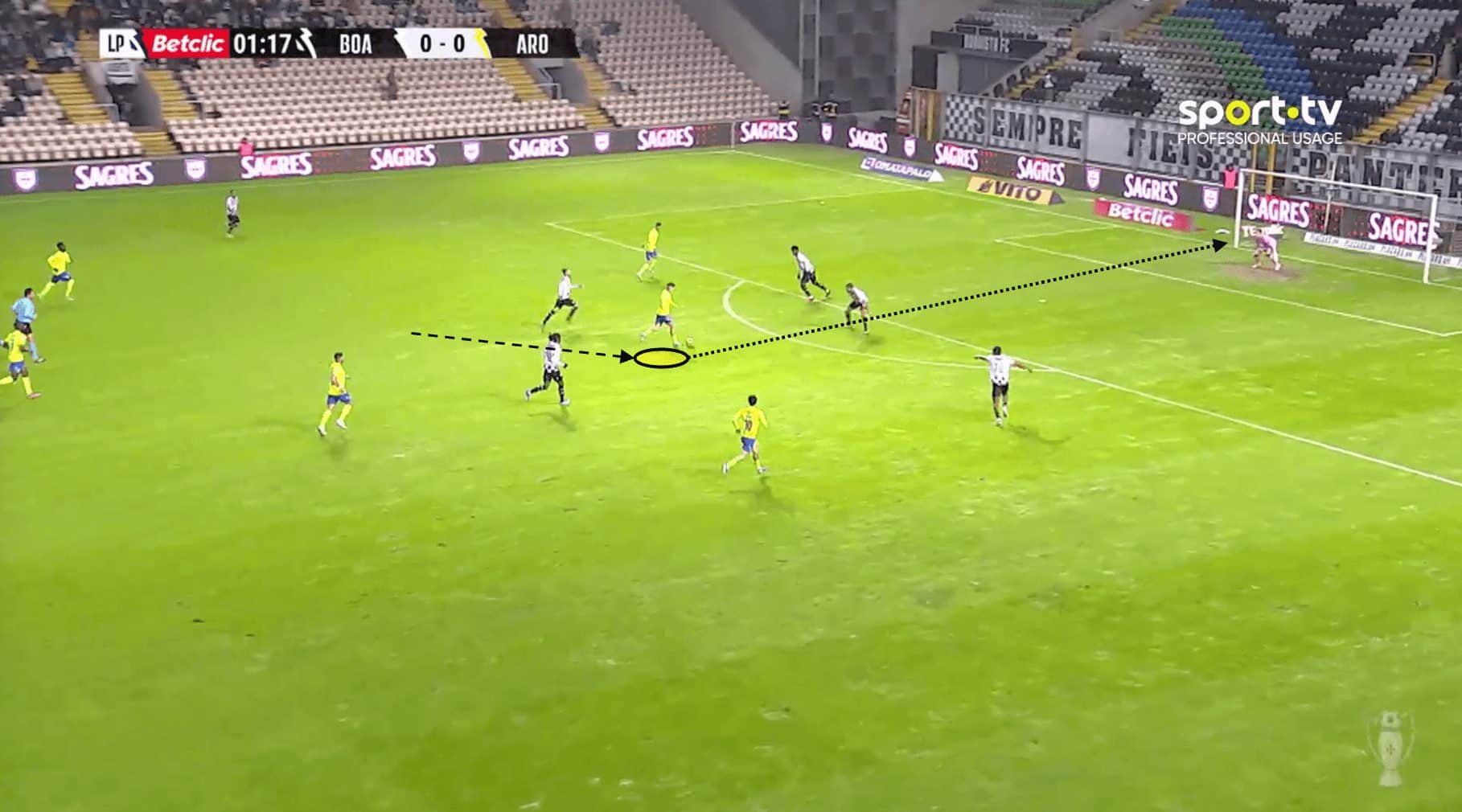
This example demonstrates Arouca regaining possession high up the pitch. As we can see, they close off passing lanes and force the Boavista defender to misplace his pass. Cristo intercepts the pass and carries the ball forward before hitting a low drive beyond the goalkeeper from the edge of the area.
Putting the opposition under pressure early in each half disrupts their rhythm and prevents them from settling into their game plan. This means Daniel Sousa’s team can force hurried passes — as we just saw — turnovers and defensive mistakes.
This creates goal-scoring opportunities and puts the opposing defence under immediate pressure, increasing the chances of Arouca scoring an early goal and gaining momentum in the match.
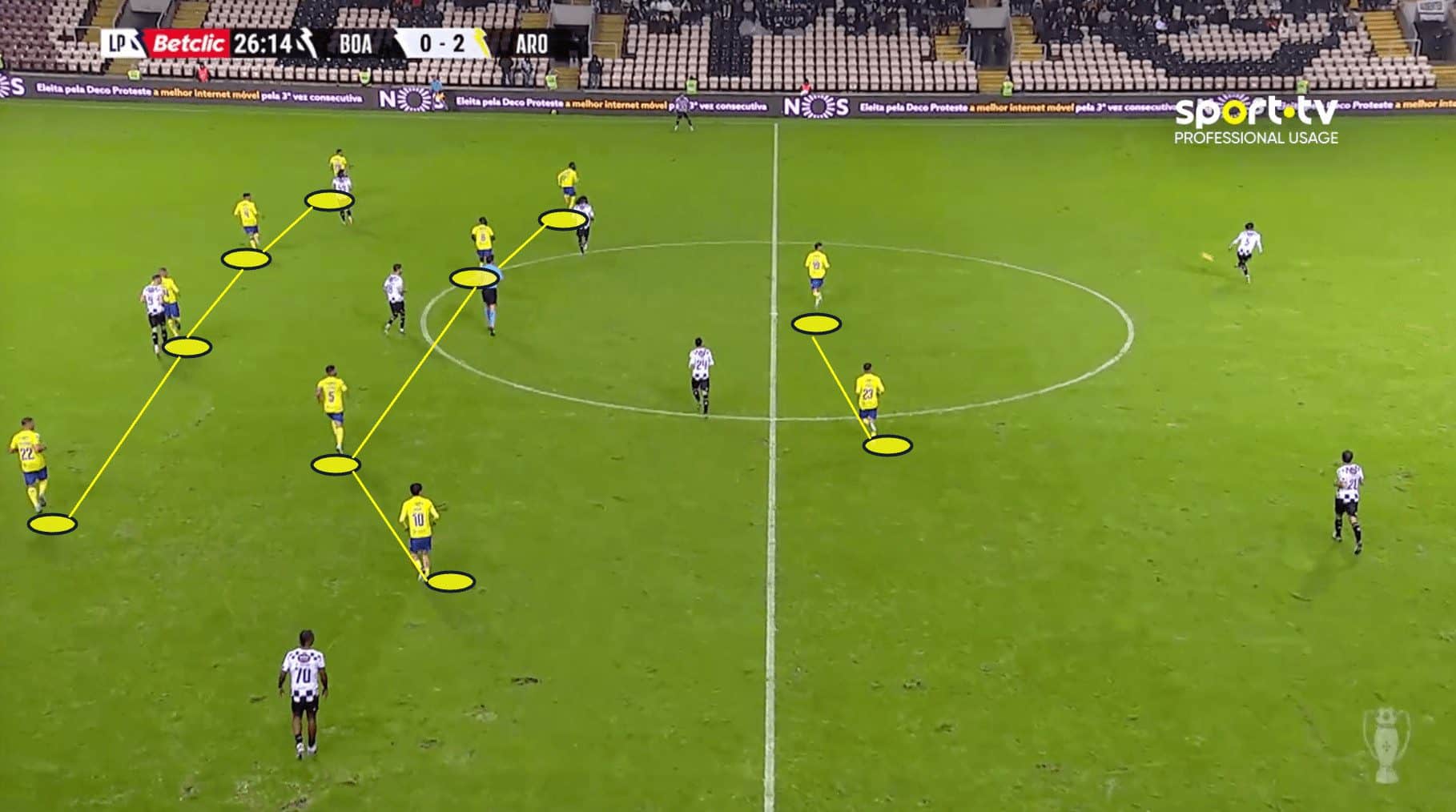
As the game goes on, Arouca looks to sit in a 4-4-2 defensive shape, often adopting a mid-block, as we can see in the image above. Sousa’s team averages 82.06 recoveries per 90, with the majority of them occurring in the middle third.
This invites the opposition to push forward in an attempt to build an attack; when they enter the Arouca half, Sousa’s team springs into a press and attempts to force a turnover.

Here we can see that Sylla presses his opponent and forces him back. From here, Arouca will often look to engage in a short, intense press looking to force turnovers. This strategic pressing means the opposition are never quite sure what Arouca are going to do next.
In this scenario, Boavista cannot completely commit players forward as they need to ensure there are players on hand to recycle possession should Arouca initiate a press. This unpredictability is a wonderful asset in Arouca’s defensive armour.
However, Arouca do maintain quite a high line which can lead to problems. The Primeira Liga team have struggled for clean sheets, conceding 1.45 goals per 90 on average this season.
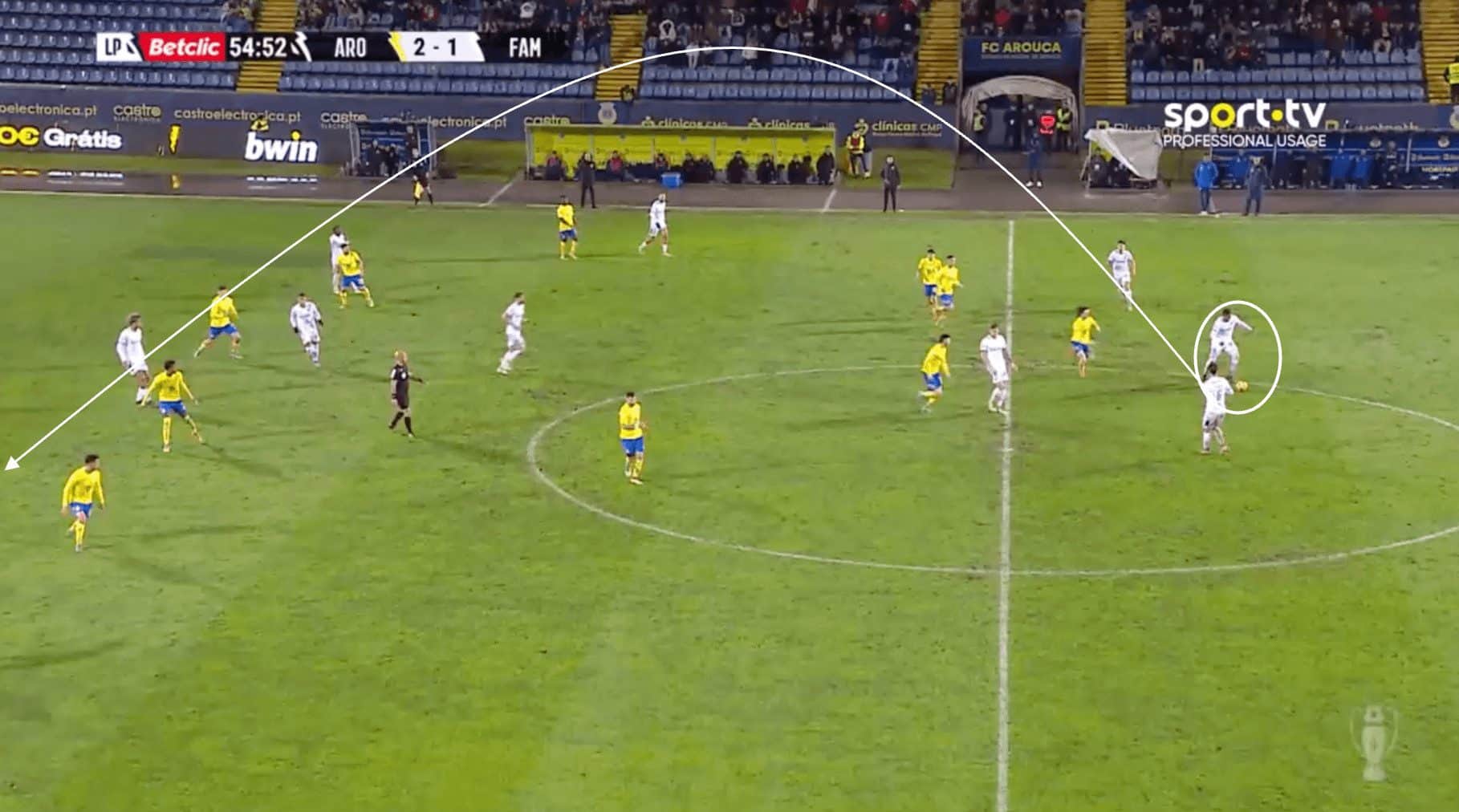
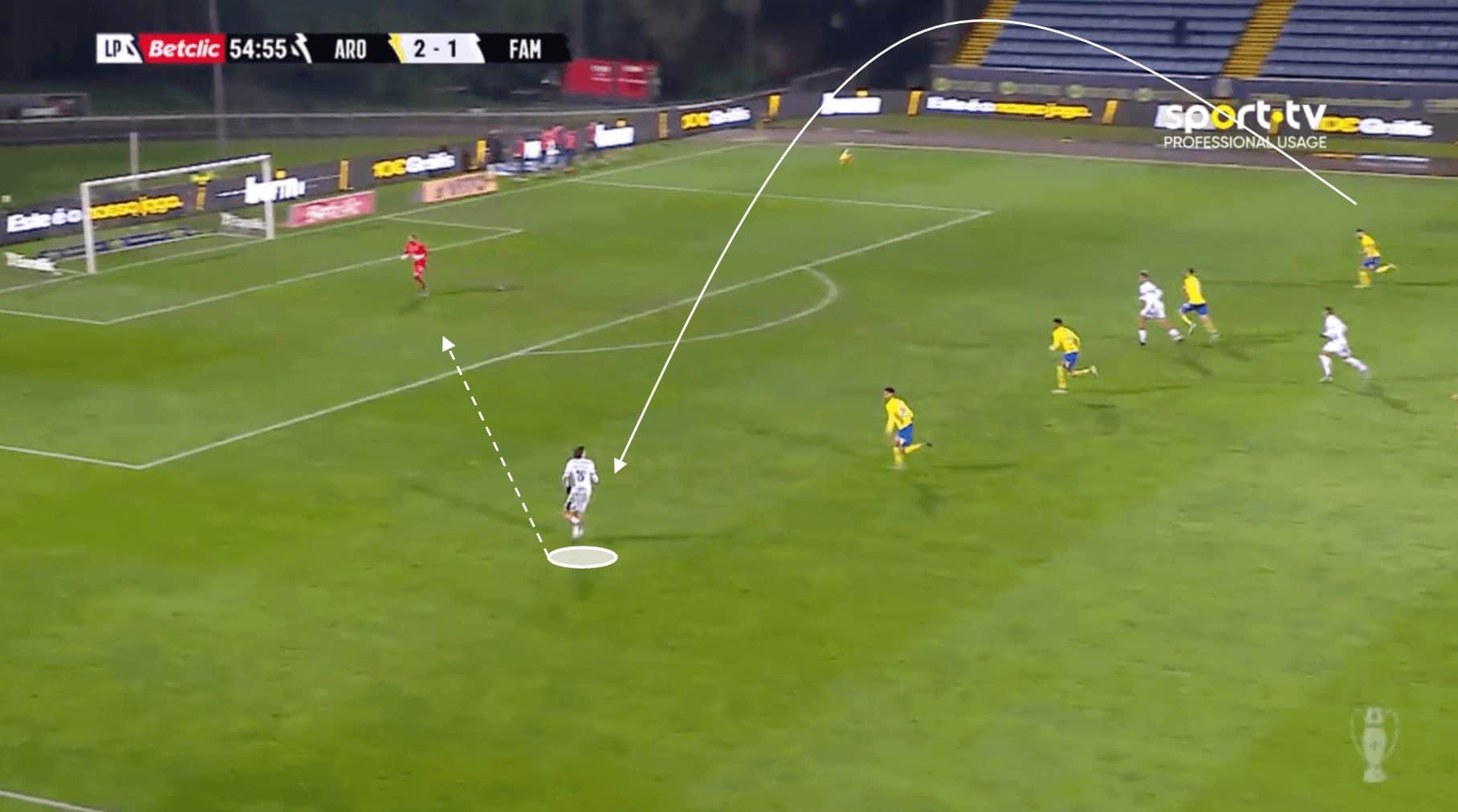
This example demonstrates just how easy it is to bypass the Arouca defence. Famalicão’s central defender hits a long pass forward, over the top of the defensive line, into the path of Gustavo Sá. As we can see, the young forward has a direct run and goal, which he exploits, carrying the ball into the box and placing a shot into the far corner, beyond the goalkeeper.
Opponents will often attempt to bypass the defensive line by playing precise through balls or lofted passes into space behind the Arouca defenders, aiming to release their forwards or wingers into one-on-one situations with the goalkeeper. Arouca’s defenders don’t always track the opposition movements, which means they find these passes difficult to defend against and lead to dangerous scoring opportunities for the opponent.
This is something that Daniel Sousa will undoubtedly be looking to change next season as Arouca’s current ‘we’ll score more than you’ style of play may not be sustainable throughout an entire season.
Conclusion
In this analysis, we have delved into Daniel Sousa’s tactics since he took charge of Arouca. We have seen how he has created a free-flowing, rapid-fire attack that can create chances out of nowhere.
Additionally, we have highlighted the Spanish trio, who are at the heart of everything Arouca do, and shown how their outstanding link-up play leads to some wonderful chances.
Finally, we have studied Sousa’s out-of-possession ideas and identified the problem areas within Arouca’s defence, which will need to be fixed if they are going to step up next season.
Although far from perfect, to take a team from rock bottom of the league to seventh place in just four months is pretty impressive. 39-year-old Daniel Sousa is certainly cutting his teeth as a manager.

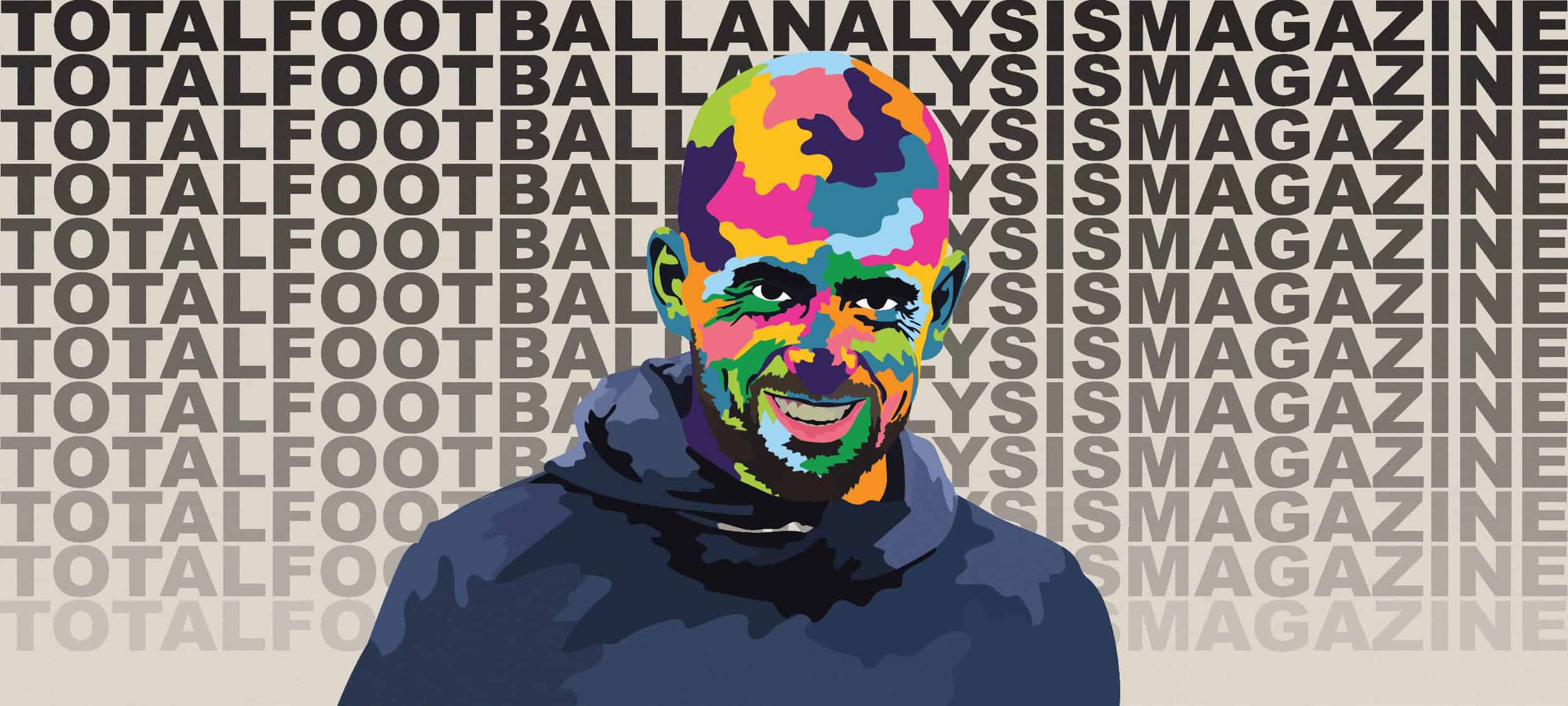



Comments